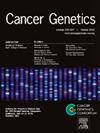探索复制应激和细胞衰老作为新型癌症治疗的关键靶点
IF 2.1
4区 医学
Q4 GENETICS & HEREDITY
引用次数: 0
摘要
在人类癌症中最常见的标志特征包括持续的细胞增殖,逃避凋亡和遗传不稳定。复制压力导致基因组不稳定,是癌前细胞和癌细胞的特征,它产生于导致显著DNA损伤的条件。在每个细胞周期中,DNA复制是一个高度控制的过程,确保准确复制DNA以分配给子细胞。细胞衰老通过停止细胞周期的进程来防止受损或老化的细胞分裂。衰老细胞经历多种变化,如代谢变化、染色质改变和自噬调节。衰老可由端粒缩短引发,导致细胞分裂数量有限(复制性衰老),或由癌基因过度表达引发,这是一种预防癌症的机制。许多被激活的致癌基因已被证明可以诱导复制应激,这是癌症发展的关键早期步骤。研究复制应激反应背后的机制可能为癌症治疗开辟新的途径,包括靶向Chk1、TLK、WEE1、ATR、MELK、PARP、NAE等途径的小分子抑制剂。本文综述了肿瘤发生过程中持续复制应激与细胞衰老之间的关系,旨在为肿瘤发生的早期阶段提供见解,并为新的癌症诊断和治疗策略的发展提供信息。本文章由计算机程序翻译,如有差异,请以英文原文为准。
Exploring replication stress and cellular senescence as key targets in novel cancer therapies
The hallmark features most commonly found in human cancers include sustained cell proliferation, evasion of apoptosis, and genetic instability. Replication stress, which contributes to genome instability and is characteristic of both pre-cancerous and cancerous cells, arises from conditions that cause significant DNA damage. DNA replication is a highly controlled process in each cell cycle, ensuring accurate duplication of DNA for distribution to daughter cells. Cellular senescence prevents damaged or aging cells from dividing by halting their progression through the cell cycle. Senescent cells undergo a variety of changes, such as metabolic shifts, chromatin alterations, and autophagy regulation. Senescence can be triggered by telomere shortening, leading to a limited number of cell divisions (replicative senescence), or by oncogene overexpression, which functions as a mechanism to protect against cancer. A number of activated oncogenes have been shown to induce replication stress, a crucial early step in the development of cancer. Investigating the mechanisms behind the replication stress response may open up new avenues for cancer therapies, including small-molecule inhibitors targeting pathways such as Chk1, TLK, WEE1, ATR, MELK, PARP, NAE, and others. This review examines the relationship between persistent replication stress and cellular senescence in carcinogenesis, aiming to provide insights into the early stages of oncogenesis and to inform the development of new cancer diagnostic and therapeutic strategies.
求助全文
通过发布文献求助,成功后即可免费获取论文全文。
去求助
来源期刊

Cancer Genetics
ONCOLOGY-GENETICS & HEREDITY
CiteScore
3.20
自引率
5.30%
发文量
167
审稿时长
27 days
期刊介绍:
The aim of Cancer Genetics is to publish high quality scientific papers on the cellular, genetic and molecular aspects of cancer, including cancer predisposition and clinical diagnostic applications. Specific areas of interest include descriptions of new chromosomal, molecular or epigenetic alterations in benign and malignant diseases; novel laboratory approaches for identification and characterization of chromosomal rearrangements or genomic alterations in cancer cells; correlation of genetic changes with pathology and clinical presentation; and the molecular genetics of cancer predisposition. To reach a basic science and clinical multidisciplinary audience, we welcome original full-length articles, reviews, meeting summaries, brief reports, and letters to the editor.
 求助内容:
求助内容: 应助结果提醒方式:
应助结果提醒方式:


